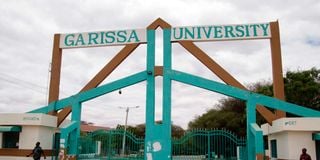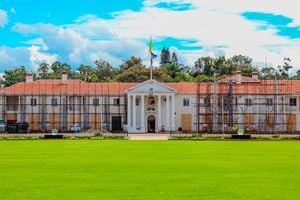After eight years, Garissa University attack left us with unsung heroes

Garissa University's main entrance as pictured on March 13, 2023.
Eight years ago today, four armed Al Shabaab militia entered Garissa University, leaving a trail of deaths. By the time they were done, they had killed 148 and injured 79. The horror of that massacre moved the security apparatus to rethink how to craft counter-terrorism messages and confront a group looking for soft targets.
Al Shabaab, and other extremist raids, have led to unwarranted criminalisation of the Muslim identity. This has interested scholars looking at how nations respond after such terror attacks.
In the most severe cases, we have seen the rise of islamophobia, where the liberties of those identified as Muslim are curtailed in various ways — all based on false stereotypes. And before we bury our heads in the sand, this matter is still with us, and provocations for religious wars are still running.
It was only this week, in the aftermath of Azimio supporters clash with police, that we had PCEA Emmanuel Centre burnt. At the same time, Masjid A-aqsa Mosque in Kibera was almost razed after a huge inferno consumed adjacent stalls.
The intention – of those behind this mayhem - was to spark a religious conflict, but this was quickly countered by the Inter-Religious Council of Kenya (IRCK), which held a press conference outside the burnt church and called for tolerance.
Those are some of the responses that came after the attempts by Al Shabaab to use religion to sow seeds of hatred. One can say that we learned positive lessons after failing the Garissa University College test, eight years ago.
First, Garissa University College, as it then was, was a perfect target. It lay within the Al Shabaab “corridor of terror” and had a population of teenagers and administrators, perhaps oblivious of the surroundings. The security and the response were slack. However, the then Principal of Garissa University College Dr Ahmed Warfa would later claim that he had brought the student safety issue to the attention of the security apparatus, but, it appears, he suffered what is known as the Cassandra curse in Greek mythology.
Thus, and most likely, he was ignored – the same way US Ambassador Prudence Bushnell wrote home regarding sub-standard safety conditions at the American Embassy in Nairobi before the August 7, 1998 bomb blast blamed on Al Qaeda.
Looking back at the Garissa attack, Kenya seems to have picked the pieces and learned some lessons. There were many mistakes than security agencies could openly admit. Actually, there was criticism that intelligence warnings indicating Al Shabaab militia had been sighted in Garissa town were ignored. By then, Rashid Charles Mberesero, Hassan Aden Hassan, and Mohamed Ali Abdikadir were already in Garissa plotting how to enter the university compound.
Mberesero had arrived from Tanzania and lived in a mosque at Mororo in Tana River County. He was found hiding in one of the hostel rooms. Hassan was a shop attendant in Mandera, while Abdikadir was a livestock trader. All these are now in jail. The other, who died during the attack, was a university of Nairobi-trained lawyer, Abdirahim Abdullahi.
This is what we know about the raid: The group struck on Thursday, April 2, 2015, at 5.30am. While storming the college campus, they were fully armed with AK-47s and explosive belts. They were masked. As they entered, the gunmen shot two guards at the main gate. They then divided into two groups and headed to the hostels and classrooms. Members of the Christian Union, who were attending morning prayers in one of the classes, were all shot dead.
By the time the police arrived, after about six hours, the gunmen had done the damage they wanted. There was apparent poor coordination of countermeasures, which explains why so many students died during the siege.
But the most apparent was the way they targeted Christians. Initially, they shot indiscriminately but later hunted down and killed Christian students while sparing Muslims. Al Shabaab have always tried to cause a rift between the two faiths but so far have not succeeded – and for a reason.
There have been deliberate attempts by faith groups associated with National Counter Terrorism Centre, which are training Muslim clergy on responding to extremist violence, and how to retrain radicalised youth returnees through counter-narratives.
Through such efforts, which go unreported, anti-Muslim rhetoric and anti-Christian propaganda are quickly extinguished – and, as a result, violent extremism is not associated with religion but with a specific terror organisation.
Garissa was not the first time Al Shabaab had tried injecting religious narratives into their terror attacks. We have had cases of buses stopped and victims profiled for elimination based on their faith. That also happened during the September 2013 Westgate Mall attack in Nairobi. However, our heroes should always be the Muslim and Christian clergy, who have mobilised their followers to reject extremism.
Religious hatred
When the Garissa attack occurred, the Shabaab spokesman, Ali Mohamoud Raghe, had even said in an audio message that they carried the attack because “the Christian government of Kenya has invaded our country.” This was in reference to Kenya’s military presence in Somalia since October 2011 under Operation Linda Nchi – and later as part of the African Union Mission in Somalia (Amisom). Raghe knows that Kenya was in Somalia to degrade Al Qaeda-affiliated militants, but he cannot survive without stirring up religious hatred.
When it emerged in mid-2000, Al Shabaab had the support of Al Qaeda and was the radical wing of the Sharia courts established by the moderate Islamic Courts Union. Some veterans of the Afghanistan war established the group, and by connecting to Al Qaeda it was seeking a global platform. The stated goal is to turn Somalia into a fundamentalist Islamic state.
The paradox is that despite all that, there has been a reluctance to list Al Shabaab under the same sanctions as Al Qaeda and the Islamic State. As Kenya’s ambassador to the United Nations, Martin Kimani, aptly put it last year, there seem to be some double standards on Al Shabaab from the international community, especially on placing it alongside Al Qaeda.
He told Africa Report: “Shabaab meets every criterion of 1267. It has publicly and repeatedly affiliated itself with Al Qaeda. We were told (a listing under 1267 would interfere with humanitarian aid. So (…) last year, we sat down with humanitarian associations and asked them: ‘What can we do?’ And they said: ‘We need carve-outs’.
“During the renegotiation of 1267 in December, we suggested these carve-outs, specifically for Al Shabaab, and it was again refused. So (we have) a situation where the Security Council seems to be unable to have a regional, strategic, global approach to situations in Africa.
Global concern
When there’s terrorism elsewhere, it’s a matter of global concern. When there’s terrorism in Africa, it’s a matter of your concern, there in Africa. It would be very sad if it weren’t funny in a macabre kind of way.”
And that is where we are now – and eight months after Garissa, the international community is still treating the group softly. And that is why the work of inter-faith institutions to ensure that Shabaab does not use the religious card is significant to us as a country.
On the eighth anniversary, we need to remember the work of all those involved in counter-terrorism strategies, for they are hardly appreciated in public. Yet, when attempts to divide the country along religious lines are made – they step into that gap.
Postscript: I thought we had done away with warmongers who incite ethnic violence. Previously, churches were platforms for peace, but a new generation of politicians are now preaching lawlessness within the church and receiving applause from the congregation. Nations collapse when faith is mixed with bad manners, hubris, and chest-thumping.
[email protected] Twitter: @johnkamau1





